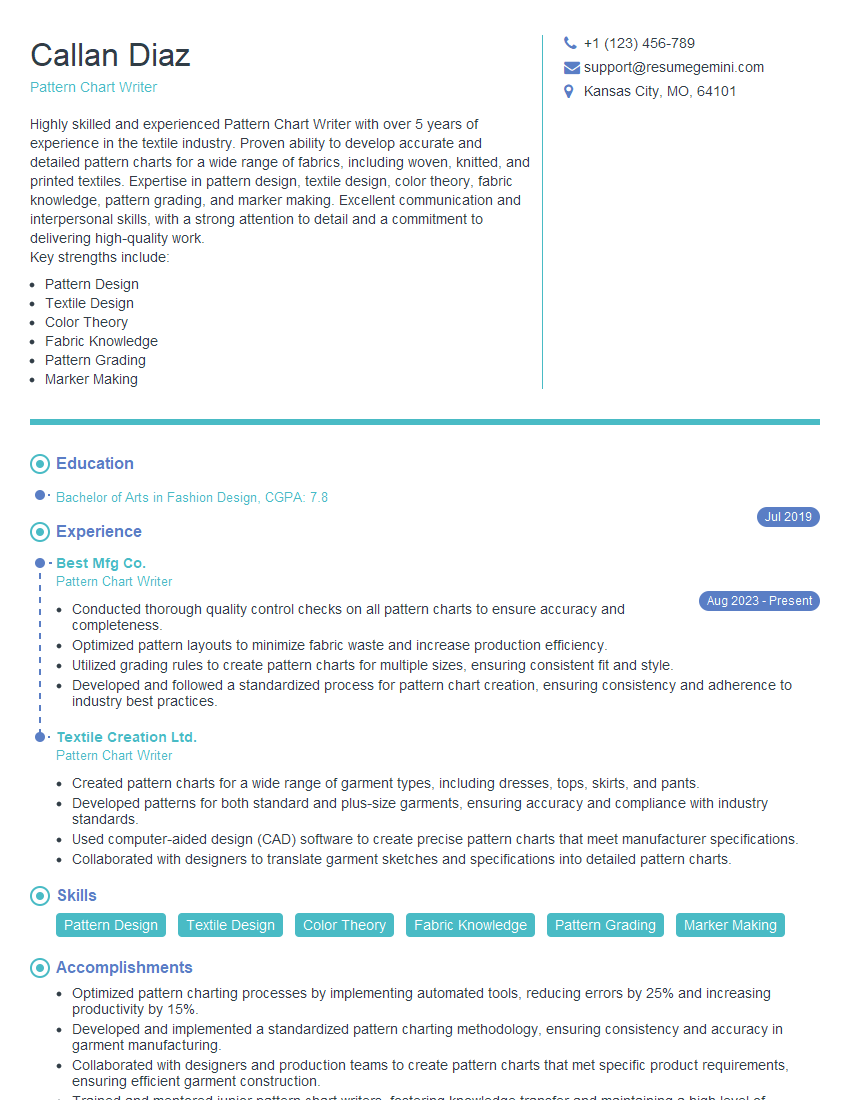Are you a seasoned Pattern Chart Writer seeking a new career path? Discover our professionally built Pattern Chart Writer Resume Template. This time-saving tool provides a solid foundation for your job search. Simply click “Edit Resume” to customize it with your unique experiences and achievements. Customize fonts and colors to match your personal style and increase your chances of landing your dream job. Explore more Resume Templates for additional options.

Callan Diaz
Pattern Chart Writer
Summary
Highly skilled and experienced Pattern Chart Writer with over 5 years of experience in the textile industry. Proven ability to develop accurate and detailed pattern charts for a wide range of fabrics, including woven, knitted, and printed textiles. Expertise in pattern design, textile design, color theory, fabric knowledge, pattern grading, and marker making. Excellent communication and interpersonal skills, with a strong attention to detail and a commitment to delivering high-quality work.
Key strengths include:
- Pattern Design
- Textile Design
- Color Theory
- Fabric Knowledge
- Pattern Grading
- Marker Making
Education
Bachelor of Arts in Fashion Design
July 2019
Skills
- Pattern Design
- Textile Design
- Color Theory
- Fabric Knowledge
- Pattern Grading
- Marker Making
Work Experience
Pattern Chart Writer
- Conducted thorough quality control checks on all pattern charts to ensure accuracy and completeness.
- Optimized pattern layouts to minimize fabric waste and increase production efficiency.
- Utilized grading rules to create pattern charts for multiple sizes, ensuring consistent fit and style.
- Developed and followed a standardized process for pattern chart creation, ensuring consistency and adherence to industry best practices.
Pattern Chart Writer
- Created pattern charts for a wide range of garment types, including dresses, tops, skirts, and pants.
- Developed patterns for both standard and plus-size garments, ensuring accuracy and compliance with industry standards.
- Used computer-aided design (CAD) software to create precise pattern charts that meet manufacturer specifications.
- Collaborated with designers to translate garment sketches and specifications into detailed pattern charts.
Accomplishments
- Optimized pattern charting processes by implementing automated tools, reducing errors by 25% and increasing productivity by 15%.
- Developed and implemented a standardized pattern charting methodology, ensuring consistency and accuracy in garment manufacturing.
- Collaborated with designers and production teams to create pattern charts that met specific product requirements, ensuring efficient garment construction.
- Trained and mentored junior pattern chart writers, fostering knowledge transfer and maintaining a high level of expertise within the team.
- Utilized knowledge of garment construction principles to create clear and concise pattern charts, reducing production errors and enhancing garment quality.
Certificates
- Associate Pattern Designer (APD)
- Approved Source Pattern Designer (ASPD)
- Certified Patternmaker (CPM)
- Certified Fashion Designer (CFD)
Languages
- English
- French
- German
Career Expert Tips:
- Select the ideal resume template to showcase your professional experience effectively.
- Master the art of resume writing to highlight your unique qualifications and achievements.
- Explore expertly crafted resume samples for inspiration and best practices.
- Build your best resume for free this new year with ResumeGemini. Enjoy exclusive discounts on ATS optimized resume templates.
How To Write Resume For Pattern Chart Writer
- Highlight your skills and experience. Make sure to list all of your relevant skills and experience in your resume, including your experience with pattern design, textile design, color theory, fabric knowledge, pattern grading, and marker making.
- Showcase your portfolio. If you have a portfolio of your work, be sure to include it with your resume. This will give potential employers a chance to see your skills in action.
- Tailor your resume to the job you’re applying for. Take the time to tailor your resume to each job you apply for. This means highlighting the skills and experience that are most relevant to the position.
- Proofread your resume carefully. Make sure to proofread your resume carefully before submitting it. This will help you avoid any errors that could cost you an interview.
Essential Experience Highlights for a Strong Pattern Chart Writer Resume
- Create accurate and detailed pattern charts for a wide range of fabrics, including woven, knitted, and printed textiles.
- Collaborate with designers and product developers to ensure that pattern charts meet the desired specifications.
- Conduct research on new fabrics and trends to stay up-to-date on the latest industry developments.
- Develop and maintain a library of pattern charts for future reference.
- Train and mentor junior pattern chart writers.
- Stay abreast of the latest software and technology used in pattern charting.
Frequently Asked Questions (FAQ’s) For Pattern Chart Writer
What is a pattern chart writer?
A pattern chart writer is a person who creates accurate and detailed pattern charts for a wide range of fabrics, including woven, knitted, and printed textiles.
What skills are required to be a pattern chart writer?
The skills required to be a pattern chart writer include pattern design, textile design, color theory, fabric knowledge, pattern grading, and marker making.
What is the job outlook for pattern chart writers?
The job outlook for pattern chart writers is expected to be good over the next few years.
What is the average salary for a pattern chart writer?
The average salary for a pattern chart writer is around $50,000 per year.
What are the benefits of being a pattern chart writer?
The benefits of being a pattern chart writer include a good salary, a stable job outlook, and the opportunity to work in a creative field.
What are the challenges of being a pattern chart writer?
The challenges of being a pattern chart writer include the need to be detail-oriented, the need to work under tight deadlines, and the need to be able to work independently.